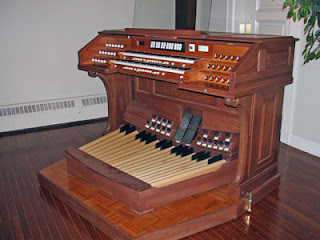 |
| Note mismatched, crumbled, and blank knobs. |
This is a huge deal! To understand... let me give you an idea of what the current console is like.
The current console was built by the Moller organ company for an organ (which no longer exists) in Allentown in the late 1940's or early 1950's. In 1976, when our organ was rebuilt, instead of making a new custom console just for our organ, the Fritzsche organ company (who rebuilt our organ and had possession of the Moller console from Allentown, and probably the pipe work too - our organ has one rank built by Moller, which Fritzsche installed). So it's not meant for our organ. Because of that, there are blank stop knobs and the bottom keyboard doesn't do anything except couple and play the harp and chimes.
In addition to this, the console physically shows wear. Being about 60 years old, many labels have broken off (so one doesn't know what certain pistons do). In addition to that, many stop knobs have crumbled because of the age of their plastic. They have been replaced (several times) with new knobs that don't match the old ones. Some knobs don't even say the correct stop names! The keys are yellow and chipped, the wood is scratched, numerous pedal coupler contacts do not work, divisional unisons and busted swell to choir couplers are busted. New problems like these occur on a regular basis.
 |
| Note mismatched knobs and crumbled labels. |
Further, the organ console is enormously tall and deep. Enable to fit all the pneumatic action inside, the shell of the console had to be huge in those days.
Lastly, the current organ console is not movable, which makes seeing an organist play during a concert impossible. This also makes it impossible for an organist to properly judge the balance between the pipes on the West side of the chancel and pipes on the East side of the chancel.
With a new console, all these problems will be solved!
 |
| Here we see the monstrous pneumatic action of the current console. |
 |
| Note yellowed keys, missing key faces, yellowed pistons, and general wear. |
With a new console, all aesthetics would match, there would be no blank knobs, all coupler contacts would work, all pedal contacts would work, all reversibles would work, and pistons would act much faster without putting any strain on the console whatsoever (as the current pneumatic system does).
The cost of a new console would be in the area of $50,000.
Our console will most likely be built by Patrick J. Murphy and Associates Pipe Organ Builders. Here are some pictures of what their consoles look like (and what ours may look like).
 |
| This movable console is in concert position so an audience can watch during a concert. |
 |
| Since people are going to see it, a new console will be much more attractive. |
 |
| Not how much shallower this console is from front to back as compared to our old Moller console. Also note how the horizontal stop jambs and flat top make the console much shorter. |
 | |||||||||||||||||||||||||||||||||||||||||||||||||
| Best of all - here is the Solid State electric action of a new console. Much smaller (as well as more versatile and reliable) than the mechanical pneumatic action in our old Moller console. |




